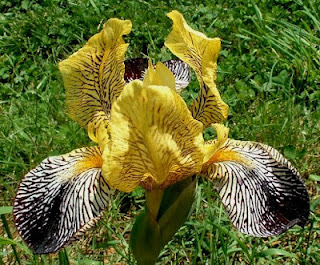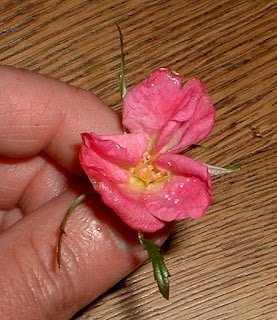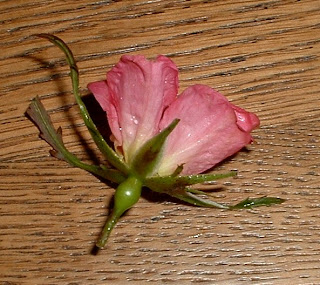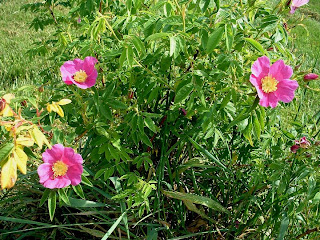
... growing and hybridizing all kinds of plants in zone 6b Maryland since the 1980's.
Wednesday, May 30, 2012
Rosa davidii x virginiana
In spite of being a cross between two tetraploids, I had thought this F1 might be relatively sterile because all of the few flowers it had last year aborted. Well, this year it's flowering much heavier and it looks like at least some of the hips are swelling (see blue arrow).


Rubus illecebrosus
Surprisingly large and slightly semi-doubled flowers for a raspberry. It's made a knee-high patch under an apple tree and needs to be moved somewhere where it won't keep scratching me up. So far it hasn't been willing to make any fruit - maybe it's not self-compatible? I did get its pollen to set a fruit on 'Anne' yellow raspberry two years ago but never got the seeds to germinate. I'd like to try it again though, because it looks like this species might have a very high druplet count (from the looks of the little green parts in the centers) which could make for very big berries.
'Fragrant Cloud' X Rosa carolina
I moved this hybrid a few years back and it had been slowly settling in. Looks like it's happy enough now, even though beetles have stripped the upper branches and all of the recent rains have made a lot of the flowers "ball". It's 'Fragrant Cloud' X Rosa carolina and is the seed parent of the one I call "MR1" (from 'Carefree Sunshine' pollen) and also of the one I call "3/4 native" (from Rosa virginiana pollen). I've posted here about these two before. In spite of being a once-bloomer, this is one of my favorite hybrids. It's healthy and has a strong "old rose" fragrance. I think I'll use fedtschenkoana pollen on it today. That would be a fun cross to see offspring from!
Saturday, May 26, 2012
Best Rosa palustris X 'Home Run'
Now that they've started blooming, and disease pressure is also currently pretty high, it's easy to see that this seedling is the best of the bunch. It's showing some black-spotting on the leaves closest to the ground, but in general is still fairly dense with healthy foliage. The flowers tend to be a little "crumpled" (sort of how 'Mutabilis' blooms usually look) but are still full enough to be pretty. And they've got a warm pink color with a light yellow eye in the center. Sadly, not much if any fragrance. And it's unlikely that there will be any repeat. But hopefully it'll be fertile enough to move this line forward.
Oenothera pilosa
Neat little (non-aggressive) Oenothera that I got from Arrowhead Alpines a few years back. I'd have to check my papers, but I'm pretty sure it was called Oenothera pilosa. I've been putting pollen on it from the sort of invasive pink Oenothera speciosa. I think I've tried it before with no luck but "hope springs eternal".
Phlox 'Minnie Pearl'
Not the most flattering picture, but it's a really nice plant - healthy, a relatively long-blooming. Got mine from ForestFarm. I think I'll divide this clump next year. And if I get a chance I might try some hybridizing - that's creeping phlox in front right of it and Phlox angustifolia 'Gypsy Love' beside it on the right. Could need to freeze some pollen because the bloom times don't usually overlap much if any.
Pods on the interploid iris seedlings
Don't know for sure until I see how many seeds are inside, but at least they're making pods. Nine on the 'Honky Tonk Blues' X 'Astra Girl' seedling and one on the 'Pink Champagne' X 'Astra Girl' seedling. There might have been more but I was trying to intercross the two and I don't think that was working too well. So I switched to using pollen from a nearby 'Honky Tonk Blues' X aphylla 'Balascuta' seedling and that seemed to have worked much better.
Viola X cooperrideri
Same two Viola X cooperrideri that I posted pictures of earlier in the season. They're the whole center of picture. They've stopped blooming now, and are spreading out to cover large areas of ground. The bottom picture shows a close-up of the foliage.
Vesca Strawberries
Small but very flavorful! A mixed pile of "White Clubhouse" and its red once-blooming, runnering parent.
Baby birds growing fast
Here are those baby birds again. I'm thinking they might be purple finches or house finches but still not sure.
Barley Harvest
The deer were chomping and birds picking apart, so I went ahead and cut the winter barley and have been letting it dry down under the porch overhang. Looks like a pretty good increase of the few heads we'd collected. No idea what variety this is - it was a construction site volunteer, most likely from seed stowed away in a bale of straw. Note the headless stalks in the close-up - those went into the bellies of the deer.
Wednesday, May 23, 2012
Baby birds
Nobody said it's always gotta be about plants right...
Still haven't figured out what kind of bird is nesting in the arborvitae out front. The mama bird is super shy and flies far away everytime I get anywhere close to the nest. I used the binoculars and if I was looking at the right bird, I think she's an even brownish-gray on top with lighter underside marked with darker streaks. The five eggs were pale blue-green with just a few dark-brown speckles. Four have hatched already - but I haven't checked to see if the last one might have hatched overnight. So cool everytime!
Still haven't figured out what kind of bird is nesting in the arborvitae out front. The mama bird is super shy and flies far away everytime I get anywhere close to the nest. I used the binoculars and if I was looking at the right bird, I think she's an even brownish-gray on top with lighter underside marked with darker streaks. The five eggs were pale blue-green with just a few dark-brown speckles. Four have hatched already - but I haven't checked to see if the last one might have hatched overnight. So cool everytime!
Iris variegata X suaveolens var. rubromarginata
Another fine hybrid that wouldn't have happened without a freezer... the pod parent Iris variegata 'Beardsley clone' blooms several months after the pollen parent Iris suaveolens var. rubromarginata. So I froze pollen to use later in the season. I've got four seedlings from the cross and two of them even as small clumps are currently sending up multiple repeat bloomstalks. They started the season off back on March 24 (see link: http://www.hort.net/lists/iris-photos/mar12/msg00060.html), and kept up an incredibly long bloom season - last bloom opened about a week or two ago on that first wave of stalks. Now the two biggest clumps (still pretty small if you see the two clump shots below) have three and two new bloomstalks respectively. I've drawn red arrows to show the new stalks. These seedlings also tend to send up very late Fall bloomstalks that usually get frost damaged.
I have to admit, they're not the prettiest looking flowers, but the breeding potential (especially for rebloom) sure is exciting! They've got a few pods almost matured from pollen of another hybrid [Iris pallida 'Kupari' x Iris suaveolens var. rubromarginata] and I'm trying pollen from a nice yellow MTB 'Yellow Flirt' on these new stalks.
I have to admit, they're not the prettiest looking flowers, but the breeding potential (especially for rebloom) sure is exciting! They've got a few pods almost matured from pollen of another hybrid [Iris pallida 'Kupari' x Iris suaveolens var. rubromarginata] and I'm trying pollen from a nice yellow MTB 'Yellow Flirt' on these new stalks.
Little metallic green-blue bee
We found this little guy inside the house, so scooped him up and took him outside. I wish I was a better photographer. It was a lot prettier "in person".
Rosa glutinosa X palustris
Here are three early morning flowers opening on Rosa glutinosa X palustris. It's especially nice to see this hybrid maturing because of the effort involved to get it. I had to freeze pollen of the very late-blooming native Swamp Rose (Rosa palustris), in order to be able to pollinate the next season, the relatively early blooming European Pine-Scented Rose (Rosa glutinosa). It was well worth all that effort though, because the hybrid still has plenty of foliage fragrance but with a scent closer to the sweet resinous scent of palustris flower buds. The plant habit is looking like it's going to be a little more vigorous form of glutinosa and the flowers are a notch better than the pure species too. When they first open like this, the darker pink of palustris is more noticeable. You can even see the pink-tinted stigma pads in the centers of these flowers - another trait palustris contributed. I hope it sets lots of seeds so I can see how the second generation might vary.
Saturday, May 19, 2012
Rose - ('Fragrant Cloud' x carolina) X virginiana
Even though it's a once-bloomer, I really like this happy little rose. It's pretty healthy as you'd expect with all the native species blood. It has a great "old rose" scent. And suckers like it wants to take over the world! I know that's a minus for many people, but I appreciate the "self-propagating" types. You just have to be careful about where you put them.
Wednesday, May 16, 2012
Striped Standard Iris
This is the third bloom season for this seedling. The pattern doesn't show as much as I'd like on the outsides of the standards, but is pretty well expressed on the insides. It's from 'Keirith' X 'Clown Pants' and is on the large end of being an MTB (Miniature Tall Bearded).
Rosa davidii X virginiana
Rosa davidii X virginiana is blooming much better this year. It's taken a long time to build up but is realtively healthy and looking like it intends to make a thicket!
Rosa palustris X 'Home Run'
Bloom detail and overall plant picture of two of the biggest seedlings from Rosa palustris X 'Home Run'. The second seedlings has the best health of these seedlings.
Saturday, May 12, 2012
Best of my diploid PBF Irises
I'd just dug these rhizomes for some iris-hybridizing friends and thought they'd make a nice picture.
One of my goals with bearded irises is to breed for intensity and overall coverage of the PBF (purple-based-foliage) characteristic. Below are two of my most advanced diploid (24 chromosome) lines. On the right are two rhizomes of "PBF plicata" which was selected as the best seedling (for both PBF and overall quality) from a cross of Iris pallida 'Kupari' X 'Rosemary's Dream'. I used this seedling as pod parent and crossed it with another 'Kupari' hybrid (from a cross with Iris suaveolens var. rubromarginata). This pollen parent didn't have much PBF but did have decent expression of red/purple edging on its foliage. My hope was to combine PBF with red/purple margins to get more purple.
The two rizomes on the left are the result. I call this one "PBF/RM". In addition to having some edging on the foliage, the PBF itself is extended a little higher up the foliage and it also extends down over the part of the leaf that encircles the rhizome. It's too late for this season, but next season I should try inbreeding these to see what kind of dosage effects my show up - because both of these, had one parent that had none or hardly any PBF. Imagine what a double dose might give.
One of my goals with bearded irises is to breed for intensity and overall coverage of the PBF (purple-based-foliage) characteristic. Below are two of my most advanced diploid (24 chromosome) lines. On the right are two rhizomes of "PBF plicata" which was selected as the best seedling (for both PBF and overall quality) from a cross of Iris pallida 'Kupari' X 'Rosemary's Dream'. I used this seedling as pod parent and crossed it with another 'Kupari' hybrid (from a cross with Iris suaveolens var. rubromarginata). This pollen parent didn't have much PBF but did have decent expression of red/purple edging on its foliage. My hope was to combine PBF with red/purple margins to get more purple.
The two rizomes on the left are the result. I call this one "PBF/RM". In addition to having some edging on the foliage, the PBF itself is extended a little higher up the foliage and it also extends down over the part of the leaf that encircles the rhizome. It's too late for this season, but next season I should try inbreeding these to see what kind of dosage effects my show up - because both of these, had one parent that had none or hardly any PBF. Imagine what a double dose might give.
Mixed Pollen Iris Experiment
This is the first seedling to bloom from my crazy mixed pollen experiment. It's basically a normal cross between two diploid Miniature Tall Bearded irises but under the influence of an overwhelming abundance of pollen from Iris psuedacorus. The plant is exceptionally [even abnormally] vigorous but I see no signs of anything "out of the ordinary" about the bud or flower. Two more flowerstalks are coming up on this young clump. It looks like it could take-over the world at the speed it's increasing.
Tuesday, May 8, 2012
Some of the winter grains
winter barley heading up nicely...
winter rye following close behind...
my "Smooth Awnless Club" wheat just starting to peak out of the tops...
and an interesting assortment of types in this F2 population from a cross of my "Pubescent Awned Club" wheat X pollen from spelt wheat. Both of my club wheats are derived from about twenty generations of selection for local adaptedness and uniformity after my first ever wheat cross [an unknown local bread wheat X 'Pima Club'].
winter rye following close behind...
my "Smooth Awnless Club" wheat just starting to peak out of the tops...
and an interesting assortment of types in this F2 population from a cross of my "Pubescent Awned Club" wheat X pollen from spelt wheat. Both of my club wheats are derived from about twenty generations of selection for local adaptedness and uniformity after my first ever wheat cross [an unknown local bread wheat X 'Pima Club'].
Charcoal
Last year, I'd read an interesting bunch of material on "terra preta", biochar and just general charcoal benefits for plants. So I bought a bag of real charcoal pieces (not briquets) from a local hardware store to play around with. I powdered some and put it around some iris seedlings in the basement that had chronically rotting roots. The change was pretty impressive! No more rotting and those seedlings finally built up some size. I dug some into the planting holes for two hardy kiwis I was planting because I'd always had problems with root rot of these too. It's a year later now and those kiwis are doing great. Keep in mind I've killed probaby six others over the years.
In the meantime, while using the storebought charcoal, I'd gotten a gift of two metal barrels (one slightly smaller to fit inside the other) and made a barrel within barrel charcoal retort following plans I'd found on-line. I made 3 or 4 batches of charcoal that way and have been using it around various plants. But... I think I may have found a way that takes less effort and can do larger batches. I just made a makeshift firepit out of cinder blocks. Here's the third batch I've made this way. The general idea is to build a fire and then when it gets going good reverse what you'd normally do and put on smaller and smaller stuff until you get to twigs. Then when the coals look to be at an optimum state (lots of coals relative to ashes) dump a bucket or two of water on it to quench all combustion. The ashes mostly get flushed away with the water leaving a big pile of charcoal. I finally got the brush pile taken care of that had been sitting out back since last October's freak snowstorm hammered the local trees; and got lots of "free" charcoal to experiment with. You can't tell very well from the pictures but this charcoal is about three inches (~7cm?) deep in the center.
In the meantime, while using the storebought charcoal, I'd gotten a gift of two metal barrels (one slightly smaller to fit inside the other) and made a barrel within barrel charcoal retort following plans I'd found on-line. I made 3 or 4 batches of charcoal that way and have been using it around various plants. But... I think I may have found a way that takes less effort and can do larger batches. I just made a makeshift firepit out of cinder blocks. Here's the third batch I've made this way. The general idea is to build a fire and then when it gets going good reverse what you'd normally do and put on smaller and smaller stuff until you get to twigs. Then when the coals look to be at an optimum state (lots of coals relative to ashes) dump a bucket or two of water on it to quench all combustion. The ashes mostly get flushed away with the water leaving a big pile of charcoal. I finally got the brush pile taken care of that had been sitting out back since last October's freak snowstorm hammered the local trees; and got lots of "free" charcoal to experiment with. You can't tell very well from the pictures but this charcoal is about three inches (~7cm?) deep in the center.
Lettuce, radishes and cabbage
A few plants set aside for seed production...
these three lettuce plants were volunteers (I don't know what variety) that overwintered behind the house, so I dug and moved them to the garden to encourage them to make lots of seed. They're about tennis ball size right now.
...two kinds of winter radishes (ones intended to be autumn grown and stored for winter use). I kept both of these kinds over winter in zip-lock bags in the vegetable/crisper section of the refrigerator. To the left of the stake is 'Long Black Spanish'. To the right of the stake is a Chinese pink-fleshed variety (the name escapes me right now). I'm hoping that the insects are intercrossing these two for some fun stuff to save over this coming winter.
these three lettuce plants were volunteers (I don't know what variety) that overwintered behind the house, so I dug and moved them to the garden to encourage them to make lots of seed. They're about tennis ball size right now.
...two kinds of winter radishes (ones intended to be autumn grown and stored for winter use). I kept both of these kinds over winter in zip-lock bags in the vegetable/crisper section of the refrigerator. To the left of the stake is 'Long Black Spanish'. To the right of the stake is a Chinese pink-fleshed variety (the name escapes me right now). I'm hoping that the insects are intercrossing these two for some fun stuff to save over this coming winter.
... and a whole patch of 'Stonehead Cabbage' that cost $2 for all dozen plants last Fall. I figured they were selling cheap because it was too late for them to make decent heads. But, that size seemed ideal to winter over and use as seed producers. There are some of my glossy kale/collard hybrids in bloom nearby and I'm hoping to find some glossy offspring among the seedlings that I eventually will grow from the seeds of these cabbages.
First open bloom - Rosa glutinosa x palustris
Some sort of night insects (beetles???) are stripping the foliage on uppermost branches of this seedling and also other roses and cherry trees. But even so, it's opened its first bloom!!! Very similar to pure glutinosa but maybe a little darker pink. I've no doubts about the hybridity though because the flowerbuds gland hairs are scented almost exactly like palustris. Glutinosa flowerbuds smell just like glutinosa foliage. I'm sure it won't repeat but it's still a fun one - very fragrant even when not in flower.
First open bloom - Rosa palustris X 'Home Run'
This first bloom to open dropped off when I touched it. It's a little on the small side and the form isn't great but it has pretty good petal substance and a warm yellow tint in the center. Not much scent and with the really damp weather this week, a lot of foliage is dropping on all but one of these seedlings (not this one). The healthiest one also happens to be the one that has the most gland hairs on its unopened flowerbuds.
Sunday, May 6, 2012
Rosa davidii
Here's Rosa davidii. I only have one hybrid from this species so far (with Rosa virginiana), but am using pollen from Rosa fedtschenkoana on it right know. Hopefully next Spring I'll be able to report on offspring from this cross.
In the second picture, I was trying to show how purplish the pink flowers look to me. I'm holding a petal from fire-engine-red 'Home Run' beside a newly opened flower and a day old one.
In the second picture, I was trying to show how purplish the pink flowers look to me. I'm holding a petal from fire-engine-red 'Home Run' beside a newly opened flower and a day old one.
Subscribe to:
Posts (Atom)

















































